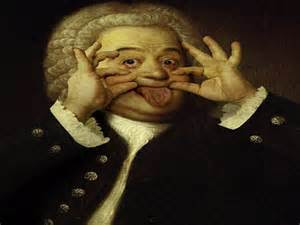“Music is a moral law. It gives a soul to the universe, wings to the mind, flight to the imagination, a charm to sadness, and life to everything. It is the essence of order, and leads to all that is good, just and beautiful, of which it is the invisible, but nevertheless dazzling, passionate, and eternal form.” Plato
What Was Bach Thinking? Pianist Puzzler Answers
 |
| Bach on Schnapps? |
You already get my admiration if you recognize the piece as Sinfonia No. 10 in G Major, BWV 796, for keyboard. Why did he write it, though, and even more pressing, how does one play it on a keyboard?
 |
| Bach Sinfonia No. 10. |
Why did he write it? This question rewards those who pay attention and read introductions. Bach explains in the introduction to his collection of Inventions and Sinfonias why he wrote them as follows: "So that those desirous of learning are shown a clear way not only (1) to learn to play cleanly in two parts, but also, after further progress, (2) to handle three obligate parts correctly and well; and along with this not only to obtain good inventions (ideas) but to develop the same well; above all, however, to achieve a cantabile style of playing and at the same time acquire a strong
 |
| Sing. |
foretaste of composition." So, in short, these are teaching pieces. Not only for learning keyboard and compositional techniques, but "above all to achieve a cantabile style of playing." Surprise. I'll bet you thought Bach on the piano was supposed to sound like a typewriter.
Finally, how is it played on the keyboard? Look at the articulation. The soprano voice crosses the alto, striking the same note with two different articulations at the same time. This is impossible. Yes, even on a two-manual instrument, if that is where you are headed. Do you see that the soprano voice plays an eighth-note C while the alto sustains the same note? The pattern is repeated in each measure sequentially. (This is no problem in my string trio version, where violin and viola happily cross lines all the time.) The explanation, of course, is that the master is here concerned perhaps a tad more about the compositional technique of voice leading than he is about keyboard techniques.
There are two possible performance options. The first is my favorite, although something is lost by removing the short eighth and replacing it with a sustained quarter.
 |
| Performance Option 1. |
 |
| Performance Option 2. |





No comments:
Post a Comment